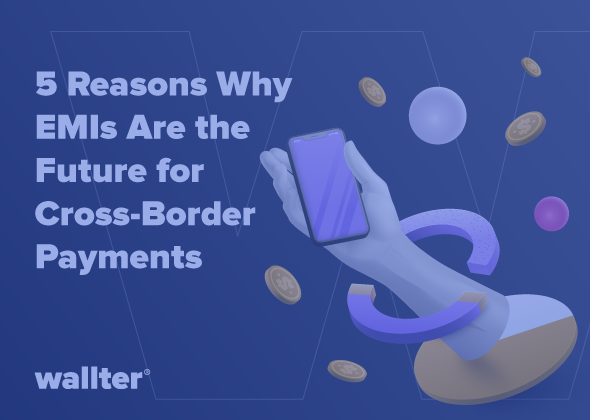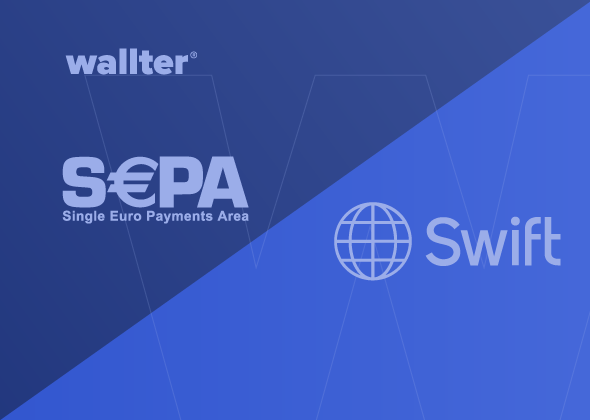The cross-border payment industry is predicted to reach $156 trillion in payment flows in 2022, around 5% (CAGR), effectively making it a trillion-dollar industry. The expected increase is fueled by numerous innovations solving the ongoing global payment challenges, as they are bound to become more frequent in the coming years.
Cross-border payments continuously improvements and innovations aim to make them cost-effective, seamless, and frictionless. Global transactions will be faster and more affordable due to digital transformation and the increasing need for real-time payments.
Major players are now racing to become first in redefining cross-border payments, including banks, fintech, financial institutions, and even entire governments. Many new players in the global payments game using the latest technologies, such as AI, VR, or quantum computing, accelerate the innovation in the financial industry.
Wallter’s experts have made a list of 5 major trends that you can expect to reshape especially B2B cross-border payments in 2022.
1. Big Banks Develop Payment Networks
Many banks join forces with other banks in neighboring countries to come up with their own payment networks. Such is the case with Singapore and Malaysia with their respective real-time payment systems PayNow and DuitNow. The residents from Singapore and Malaysia will use their mobile numbers to transfer funds between the two countries, as stated in the joint statement by The Monetary Authority of Singapore (MAS) and Bank Negara Malaysia (BNM).
Another partnership between EBA CLEARING, SWIFT, and The Clearing House occurred, joining forces to start a cross-border payments initiative dubbed Immediate Cross-Border Payments (IXB). Its goal is to make cross-border transfers faster and easier. The initiative already had a successful proof of concept, and the development has already started.
We believe that these examples above are just setting the ground for further developments in this area, as more such partnerships are expected to take place in the future.
2. Financial Institutions Blockchain Adoption
Even though blockchain and cryptocurrencies have been major buzzwords in the past couple of years, most financial institutions have slowly opened to this technology and preferred to adopt a detached attitude. However, some of the latest findings reveal that blockchain can significantly help with cross-border payments. Juniper Research published a report claiming that banks’ cost savings will increase from $301 million in 2021 to $10 billion by 2030 if blockchain is implemented, allowing better speed, transparency, and traceability in cross-border payments.
Moreover, some major companies, including Microsoft and Tesla, started accepting cryptocurrencies, leading to many established payment companies starting crypto-related initiatives. For instance, both Mastercard and Visa started exploring the crypto space slowly but securely.
3. CBDCs
CBDC stands for a central bank digital currency, a cryptocurrency backed by an official government of a country and built using blockchain and related technologies. Almost 90% of central banks worldwide are currently closely observing blockchain technology and cryptos, weighing these technologies’ main advantages and disadvantages.
The European Central Bank (ECB) started an initiative to explore the possibilities of introducing a digital euro. Its main focus was to explore the use of such a currency in the cross-border context. Many other banks are following suit, with some already making significant progress, such as the Bank of China.
4. Open Banking
Open banking represents an idea where users can securely share their banking information online, under the conditions they approve of, to facilitate payments, making them more secure and affordable. Essentially, open banking advocates for banks to open up and provide open APIs to let third-party developers build apps and services around them.
This would result in more innovations, transparency, and, ultimately, easier cross-border payments. The current open banking industry is worth about $4 billion, but a study from Juniper Research suggests it could reach $116 billion by 2026.
5. Payments-as-a-Service (PaaS) platforms
In a business environment of “X-as-a-service”, payments make no exception. Payments-as-a-Service (PaaS) providers have created all-inclusive, groundbreaking, cloud-based platforms that fulfill the majority of the operations, such as card issuing, payments clearing, cross-border payments, disbursements, e-commerce gateways and more.
With PaaS, companies no longer have the overloading need to build their systems and develop relationships with payment networks or banks. Also, as new functionalities become available, PaaS providers can quickly add features to their platforms.
The global Payments-as-a-Service market size is expected to reach $25.7 billion by 2027, expanding at a CAGR of 16.9%, according to a report by Grand View Research, Inc. So, all eyes on PaaS platforms as they can take the cross-border payments industry to the next level.
Final Thoughts
The cross-border payments landscape is becoming increasingly fragmented and competitive with emerging new technologies that aim to solve pain points like delays, high costs, and lack of transparency.
These trends will influence the overall movement from the physical to the digital world of payments. Businesses must redefine the way they perceive cross-border payments and priorities the strategy for building or reshaping their global operations infrastructure.
If you need help rethinking your cross-border payments, you can always contact Wallter’s payment experts and set a personal consultation about how can your company perform better global transactions.



